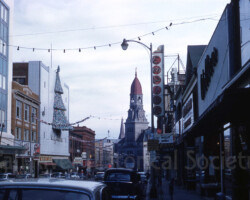Collections of the Fall River Historical Society
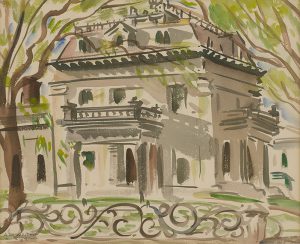 |
Since its incorporation in 1921, Fall River Historical Society has been actively acquiring material pertaining to the history of the city of Fall River, Massachusetts, and has amassed a vast collection, the majority of which is accompanied by detailed provenance. A tragic set-back occurred on the evening of February 2, 1928, when a devastating conflagration destroyed a large section of Fall River’s business district. Among the victims, and situated almost in the center of the burned out area, was the supposedly fire-proof Buffington Building, which housed the office and exhibit room of the FRHS. The entire collection was lost, except for a selection of important items stored in a safe, which survived the inferno unscathed. Undaunted, the organization immediately resumed gathering material, thereby forming the nucleus of the collection as it exists today. The diverse collections of the FRHS continue to grow in all categories, and include:
In order to address the specific needs of the collection, the FRHS maintains a stringent collecting policy. All accepted material must fill a particular need, upgrade or broaden the scope of existing collections, and have a connection to the history of the city of Fall River and its people. Items from the FRHS collections have been exhibited at institutions nationwide, including: American Folk Art Museum; Art Institute of Chicago; The Cahoon Museum of American Art; Fenimore Art Museum; Herbert Hoover Presidential Library and Museum; The Metropolitan Museum of Art; The Museum of Fine Arts, Houston; Old Colony Historical Society; Nantucket Whaling Museum; Rhode Island Historical Society; RISD Museum; Rotch-Jones-Duff House and Garden Museum; Smithsonian Institution; and Winterthur Museum, Garden and Library. Likewise, images of items from the collections have appeared in publications worldwide. The vast majority of the FRHS’s holdings are acquired by gift. In addition, we seek out and purchase items of historical importance through donations made to our Acquisition Fund. Gifts to this fund may be identified as either memorial or honorary contributions. Donate to the Fall River Historical Society’s Acquisition Fund. |
 |
|
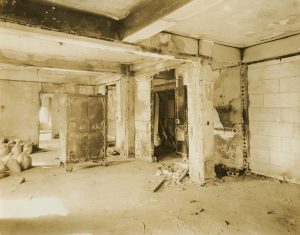 |
Americana
Objects produced in America that quintessentially define the cultural heritage and history of the United States and its people are contained in our Americana collection. Included are a wide variety of items dating from the 18th to the mid-20th century that clearly exemplify the American experience. Examples include: the so-called “Morton Eddy flagstaff” carried by Deacon Morton Eddy (1797-1888) in the War of 1812; an early 19th century Liberty Cap flagpole finial; and reverse-on-glass portraits of George and Martha Washington by William Matthew Prior (1806-1873).
Costumes and Accessories
Several thousand garments and accessories dating from the 18th century to the mid-20th century are preserved in our costumes and accessories collection, which reflects the history of changes in fashion and the culture, social mores, and ethnicity of the city of Fall River. The majority of examples are accompanied by a detailed provenance, linking them to the Fall Riverites who wore them and, in many cases, the circumstances of their being worn.
Holdings include garments worn by women of all classes. Among them are labels of well-known American and European designers. A large selection of undergarments and lingerie is also represented, as is clothing for children and young adults. Men’s clothing includes formal wear and military and fraternal uniforms. Fashion accessories include fans, footwear, hats, hosiery, and jewelry.
Decorative Arts
We maintain a large collection of decorative arts that reflects the various domestic tastes and trends popular in the 19th and early 20th centuries. Included are American, European, and Asian glass, porcelain, pottery, silver, objets d’art, and textiles. All examples were either owned by city residents or created in Fall River.
Ephemera
Our ephemera collection supplements the Society’s other holdings, with a strong emphasis on mid-to-late 19th century items. Materials cover a wide variety of topics, from civic and religious to social and entertainment. Included are advertising pieces, fashion plates, maps, posters and broadsides, prints, and the most comprehensive collection of Fall River postcards extant.
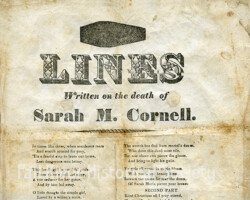
The body of Sarah Maria Cornell (1803-1832), a “mill girl” employed at the Fall River Manufactory, was discovered on December 21, 1832, hanging in a stack-yard on the farm of John Durfee in Tiverton, Rhode Island (now Fall River, Massachusetts); an autopsy revealed that the victim was pregnant. The Reverend Ephraim Kingsbury Avery (1799-1869), a Methodist minister, was accused of the crime due to incriminating evidence left by the victim. Following a sensational trial, considered a cause célèbre of the era, he was acquitted on June 2, 1833. The perpetrator of the crime was never brought to justice.
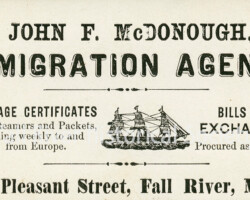
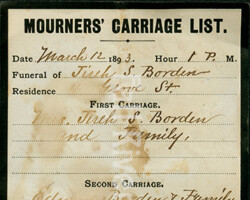
The smudged ink may be evidence of the rain that occurred on the day of the funeral, which was described by contemporary diarist Roann R. (Sanford) Freelove as “cloudy and wet.”
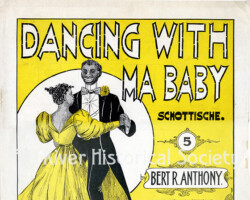
The racial stereotypes of the era are evident in the artwork illustrating this piece.
Fall River Textile Industry
Our collection of material relating to the city’s once thriving textile manufactories is extensive, and contains rare records dating back to the dawn of the industry. Included are architectural and insurance plans, business records and manuscripts, fabric samples, photographs, swatch books, and related ephemera.
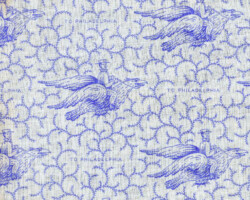

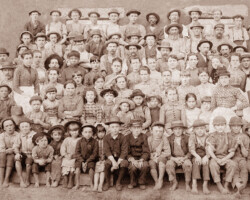
Albumen print, American, unidentified photographer.
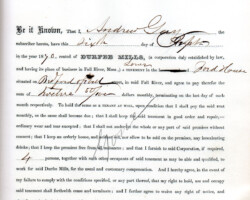
Tenement Lease Book, Durfee Mills, “31st August 1868 to 23rd August 1871 inclusive.”

Wood engraving on paper, E. R. Morse (American, 19th century).
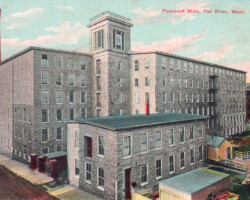
Furniture
We hold a large collection of furniture dating from the 18th to the late 19th century, including a number of pieces that remain in situ in the museum building. The majority of the pieces in the collection bear a detailed provenance connecting them to the Fall Riverites in whose residences they were once displayed.
Local History
A myriad of items dating from the 19th to the 20th century can be found in our local history collection, which documents various aspects of the city’s rich past and includes objects and architectural elements, several of which are unique in nature. Examples include: fragments of the brass ornamentation from the so-called Skeleton In Armor, discovered in Fall River in 1832, and celebrated on paper by Henry Wadsworth Longfellow (1807-1882) in his 1840 poem of the same name; and pieces of the Buttonwood Tree, which originally delineated the boundary between Fall River, Massachusetts, and its southern neighbor, Fall River, Rhode Island.
Manuscripts
Family and personal papers, business and church records, corporate and legal documents, diaries, and journals are among the items in our manuscript collection. The material in the collection dates from the late 17th to the mid 20th century, with a strong concentration of items from the mid 19th to the early 20th century.
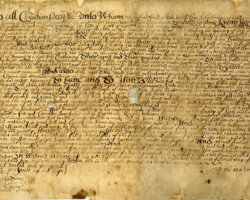
The Mason and Butterworth families were early settlers in Swansea; their descendants became leading citizens in nearby Fall River, Massachusetts.
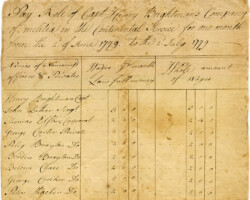
Serving in the company was Boston Durfee, a “Negroman”; listed with the rank of Private, he earned the same wage as his fellow soldiers.
On November 16, 1788, in Freetown, Massachusetts, Boston Durfee, an African-American patriot, married Sarah Slocum ”alias Dick”; evidenced by his surname, he was likely a former slave.
The slave trade between New England and the West Indies was established in the 17th century, with Newport, Rhode Island, as its chief marketplace. Some early residents in the area that is now Fall River invested in slaves, using them as farmhands and domestic servants. Thomas Durfee (1643-1712), the first settler of that surname in New England, owned a slave named Jack, bequeathing him to his wife, Deliverance (Hall) Tripp Durfee (?-1721) in his will, which was proved on July 14, 1712: “To wife, Deliverance, a negro called Jack, for life, and at her death the value of said negro, equally, to two daughters.” It was a common practice for slaves to adopt the surname of their owners, hence Jack was known as Jack Durfee. Wills and estate inventories of other early residents in the area that is now Fall River list slaves, bequeathed to heirs of the deceased along with other property. Slavery was abolished in Massachusetts in 1783.

Fall River was called Troy from June 1, 1804, to February 12, 1834. Early town records are rare, due to several fires during the 19th century; the charred binding and water damage to this ledger is evidence of one of those conflagrations.

The body of Sarah Maria Cornell (1803-1832), a “mill girl” employed at the Fall River Manufactory, was discovered on December 21, 1832 hanging in a stack-yard on the farm of John Durfee in Tiverton, Rhode Island (now Fall River, Massachusetts); an autopsy revealed that the victim was pregnant. The Reverend Ephraim Kingsbury Avery (1799-1869), a Methodist minister, was accused of the crime due to incriminating evidence left by the victim. Following a sensational trial, considered a cause célèbre of the era, he was acquitted on June 2, 1833. The perpetrator of the crime was never brought to justice.
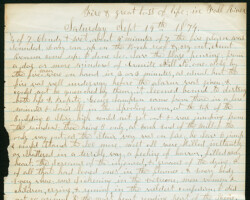
The diaries cover the years 1858 – 1895 and offer a fascinating glimpse into the day-to-day activities of a busy, middle-class working woman during Fall River’s most prosperous period.
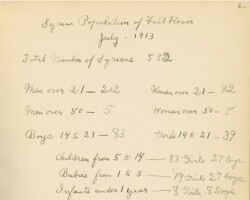
This unpublished journal of detailed statistical and biographical accounts was compiled by Alice Brayton for use in the Social Services Department of the Union Hospital in Fall River, Massachusetts. It contains important historical material about an ethnic group in Fall River that has yet to be thoroughly researched.
Maritime
Fall River’s seafaring history is documented in our maritime collection, with a strong emphasis on the steamships of the famous Fall River Line. Included in the collection are important paintings by Antonio Nicolo Gasparo Jacobsen (1850-1921) and Fred Pansing (1844-1912), among other works, and objects pertaining to various aspects of the city’s nautical history and its natural, deepwater port.
Paintings, Drawings, and Sculpture—Nineteenth Century
Our collection of paintings, drawings, and sculpture includes an array of American and European works ranging from portraits to landscapes and still life. Included are a number of works by the artists of the so-called Fall River School, as well as pieces by lesser-known local artists. Sculpture includes portrait busts and decorative works executed by American and Italian artists, including a prized example by the noted expatriate neoclassical sculptor Hiram Powers (1805-1873).
Paintings, Drawings, and Sculpture—Twentieth Century and Contemporary
The FRHS is expanding its holdings in this category and is actively acquiring artwork by Fall River natives or by artists with a city connection and views of Fall River and its environs. Twentieth century works include paintings, drawings, and sculpture. Included are later pieces by artists of the so-called Fall River School, and examples by Fall River natives George Bradford Ashworth (1892-1951), Carder Hazard Durfee (1915-2003), and Howard Kanovitz (1929-2009), among others. Contemporary works include a series of commissioned masks of historical subjects by the Fall River artist David Mello.
Photographs
The most comprehensive assemblage of views of Fall River and its people, our photograph collection documents the changing landscape of the city’s public and private spaces, its cultural development, and the faces of its inhabitants. Included are thousands of images in various formats dating from the dawn of photography to the late 20th century.
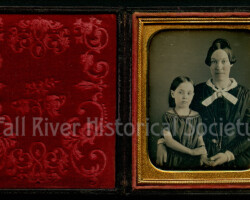
The brooch Mrs. Wilbur is wearing in the photograph, which contains a portrait miniature of her son George Wilbur (1844-1848), is preserved in the Costumes and Accessories Collection of the FRHS.

Deemed “an eccentric outburst of extravagance,” this double mansion had twenty-two rooms on its first and second floors; its elaborate furnishings included a pipe organ. The building was divided in two in 1906 and renovated as multi-family units. It still stands at 547-549 and 551-555 North Main Street, sans the grandeur of another age.

The ruins depicted in the front of this image evidence the structures razed for the construction of the Bank Street Armory and the Fall River Public Library. The large domed roof visible in the background is that of The Casino, 162 North Main Street, “between Elm and Pine.” The popular “first class” entertainment venue was billed as “The Largest Place of the Kind in New England.” None of the buildings depicted in this image survive today.
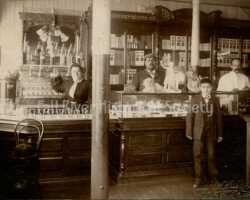

McCue was arrested on October 27, 1923, and charged with “Larceny 2 counts.” A native of Scranton, Pennsylvania, the forty-year-old prisoner carried 220 pounds on her “5′-7 ¼” frame; she was employed as a “Sales Lady” and a “Demonstrator for Ponds Digestans,” a then-popular remedy for indigestion.



